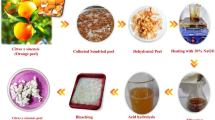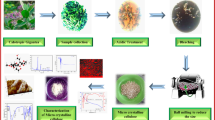Abstract
Orange mesocarp was obtained after removal of the epicarp and the endocarp from oranges. It was dried, pulverized and digested with 2% w/v sodium hydroxide at 80°C for 3 h. Alpha- and micro-crystalline celluloses were extracted from the pulp using 17.5% w/v and 2.5 N hydrochloric acid, respectively. The physicochemical and powder properties of the extracted material were evaluated. Results obtained showed that the yield of α-cellulose from the orange mesocarp was 62.5% and that of microcrystalline cellulose 25.3%. The total water-soluble substances were 0.0018 g/g, ash 0.00035 g/g and the true density 1.760 g cm−1, while the pH and hydration capacity are 6.61 and 2.916, respectively. Elemental analysis of the cellulose ash shows the absence of Pb and Mn and the preponderance of K, Na and Fe. The water sorption profile of the microcrystalline cellulose was also studied.


Similar content being viewed by others
References
Akaranta O, Amadi EA (2000) The plasticisation of a Jatropha oil Alkyd of a nitrocellulose coating material based on Musanga Ceropiodes wood and orange mesocarp. Surf Coatings Int 5:243–245
Akaranta O, Osuji IC (1997) Carboxymethylation of orange mesocarp and the utilisation in drilling mud formulations. Cellulose Chem Technol 31:193–197
Barry PSI (1975) A comparison of concentration of lead in human tissues. Br J Ind Med 32:119–139
Bean HS, Becket AE, Carless JE (eds) (1967) Advances in Pharm Sci. vol 2. Academic Press, London, p 198
Bhimte NA, Tayade PT (2007) Evaluation of microcrystalline cellulose prepared from sisal fibres as a tablet excipient. AAPS Pharm Sci Tech 8(1). DOI 10.1208/pt0801008
British Pharmacopoeia (1993a) HMSO Press, London, vol 1, p 53
British Pharmacopoeia (1993b) HMSO Press, London, vol 1, pp 119–120
British Pharmacopoeia (2004) Stationary office. The Department of Health, pp 405–407
Carr RL (1965) Evaluating flow properties of solids. Chem Eng 18:163–166
Carr RL (1970) Particle behaviour, storage, and flow. Bri Chem Eng 15:1541–1549
Carter SJ (2000) Copper, Gunn’s Tutorial Pharmacy, 6th edn. CBS Pub and Dist New Delhi, India, p 223
Celic M, Okutgen E (1993) A feasibility study for the development of a prospective compaction functionality test and the establishment of a compaction bank. Drug Dev Ind Pharm 19:2309–2334
Chilamkurti RN, Rhodes CT, Schwartz JB (1982) Some studies on compression properties of tablet matrices using a computerized instrumental press. Drug Dev Ind Pharm 8:63–86
Enezian GM (1972) Direct Compression of Tablets using Microcrystalline Cellulose. Pharm Acta Helv 47:321–363. In ref. Kibbe (2000)
Hanna M, Biby G, Miladinov V (2000) Production of microcrystalline cellulose by reverse extrusion. United States Patent Document, No. 6,228,213
Jain JK, Dixit VK, Varma KC (1983) Indian J Pharm Sci 45:83–85
Kibbe AH (ed) (2000) Handbook of Pharmaceutical Excipients, 3rd edn, pp 96–111
Korhonen O, Pohja S, Peltonen S, Suihko E, Vidgren M, Paronen P, Ketolainen J (2002) Effects of physical properties for starch acetate powders on tabletting. AAPS Pharm Sci Tech 3(4):Article 34
Kornblum SS, Stoopak SB (1973) J Pharm Sci 62(1):43–49
Lachman L, Lieberman HA, Kanig JL (1990) The Theory and Practice of Industrial Pharmacy. Henry Kimpton Publishers, London, p 320
Ofoefule SI, Chukwu A (1999) Application of blends of MCC-Cissus gum in the formation of aqueous suspentions. Boll Chim Farmaceutico 138(5):217–222
Ohwoavworhua FO, Kunle OO, Ofoefule SI (2004) Extraction and characterisation of microcrystalline cellusose derived from luffa cylindrica plant. Afr J Pharm Res. Develop. 1(1):1–6
Okhamafe AO, Azubike CPC (1994) Direct compression studies on low-cost cellulose derived from Maize Cob. J Pharm Sci 1:26–29
Okhamafe AO, Ejike EN, Akinrinola FF, Ubane-Ine Degbo (1995) Aspect of Tablet Disintegrant Properties of Cellulose derived from Bagasse and Maize Cob. J West Afr Pharm 9(1):8–13
Okhamafe AO, Igboechi A, Obaseki TO (1991) Celluloses extracted from groundnut shell and rice husks 1. Preliminary physicochemical Characterization. Pharm World J 8(4):120–130
Omray A, Omray P (1986) Evaluation of microcrystalline cellulose as a glidant. Indian J Pharm Sci 48:20–22
Ono H, Yamada H, Matsuda S, Okajima K, Kawamoto T, Iijima H (1998) 1H-NMR relaxation molecules in the aqueous suspension systems and their viscosity. Cellulose, 5:231–247. In: Peter Klinebudde AAPS Pharm Sci Tech 2000, 2(2):2
Osol A (1980) Remingtons pharmaceutical sciences, 16th edn, p 272
Pomeranz Y, Meloan CE (eds) (1994) Food analysis: theory and practice, 3rd edn. Chapman and Hall, p 608
Proencal P (1999) United States Patent Document, No. 5,879,463
Saleh TM, El-Ashmay AE (1978) Alkaline pulping of mixed reed and bagasse. J Appl Chem Biotechnol 28:721–726
Stamm AF (1964) Wood and cellulose science. The Ronald Press Company, New York, In ref. Ohwoavworhua (2004)
The International Pharmacopoeia (1979) vol 1, 3rd ed. General Methods of Analysis, WHO Publication, p 161
United States Pharmacopaea (2004) National Formulary 22, vol 27, pp 2845–2846
Wallace JW, Cappozi JT, Shangraw RF (1983) Performance of pharmaceutical fillers/binders as related to methods of powder characterization. Pharmaceutical Technol 7(9):94–104
Acknowledgements
The author greatly acknowledges the assistance of Chime Chizoba who helped in doing some of the practical work.
Author information
Authors and Affiliations
Corresponding author
Rights and permissions
About this article
Cite this article
Ejikeme, P.M. Investigation of the physicochemical properties of microcrystalline cellulose from agricultural wastes I: orange mesocarp. Cellulose 15, 141–147 (2008). https://doi.org/10.1007/s10570-007-9147-7
Received:
Accepted:
Published:
Issue Date:
DOI: https://doi.org/10.1007/s10570-007-9147-7




